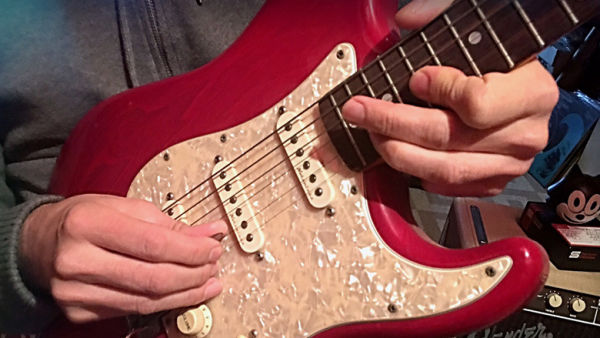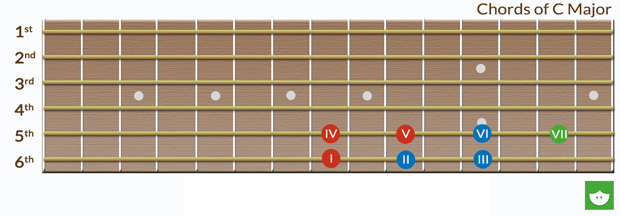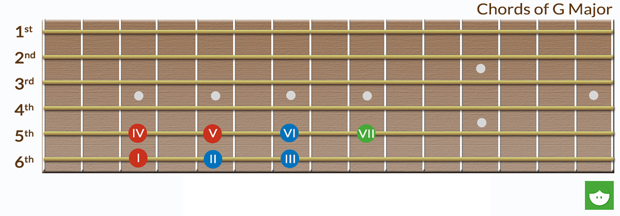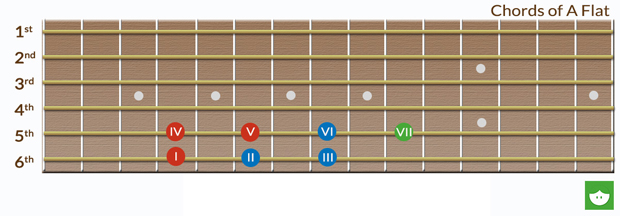Achieving Absolute Fretboard Mastery, Part 11
Get a comprehensive and absolute understanding of what modes are.

Hey, guys. Welcome to Part 11 of my "Absolute Fretboard Mastery" series.
In this month’s lesson, I want to talk a bit about modes, which is a very interesting area of music theory. The great thing about modes is that once you master them, they can give you a whole new degree of freedom when creating melodies and composing solos. But they also can be a bit tricky to understand at first.
So what I’m going to do is divide this body of knowledge into two parts and keep things as simple as I can to give you a comprehensive and absolute understanding of what modes are.
To start off, let’s go back to Part 6 of this series, where I spoke about chord progressions. You’ll recall I mentioned that when we’re in any major key, our I, IV and V chords are major and our ii, iii and vi chords are minor.
For example, if we’re in the key of C major, our major chords, or our I, IV and V chords, are C major, F major and G major. Our minor chords, or our ii, iii and vi chords are D minor, E minor and A minor. In addition, we have our vii chord, which is a B diminished.
It can sometimes be hard to recall all seven chords of a major key off the top of our head, especially when the key has sharps and flats, which is why we used a little visualization technique based on the root notes on our sixth and fifth strings to figure out our chord positions, even if we don’t know what those chords are.
For example, if we apply this visualization technique to the key of C major, our chords would be spread out like this:

The great thing about this visual pattern is that we can apply it to any major key and figure out the seven chords in that key.
For example, to figure out the chords in the key of G major, all we have to do is move the pattern up so that the I chord is on G:

We can do this for relatively harder-to-figure-out keys, such as A flat:

Don’t get me wrong, I’m not saying you shouldn’t be thorough with your theory. As you progress as a guitarist, your theoretical knowledge should develop to such an extent that you know what your I through vii chords are no matter what key you’re in. But in situations where you need to quickly figure out which chords to play without actually knowing them, this visualization is a great tool.
Going back to the key of C, we have our three major chords, which are C major, F major and G major. We also have our three minor chords, which are D minor, E minor and A minor. In addition we have our vii chord, which is the B diminished chord; but it isn’t really used as much functionally as the other six chords. If you’ve taken a look at the chord progressions in a few rock, blues or pop songs, you would have noticed the chord progressions in these songs tend to mostly revolve around the C major (I) and the A minor (vi) chords.
For example, a typical verse-chord progression would go from A minor (vi) to F major (IV) to G major (V), and a typical chorus chord progression would go from C major (I) to G major (V) to A minor (vi) to F major (IV). Now in general terms, here we would say we’re in the key of A minor for the verse and the key of C major for the chorus. But what we’re really doing is emphasizing a different chord while remaining in the key of C.
So a mode, in the most simplest of terms, is simply a way of referencing which scale degree or chord we’re emphasizing in a particular key. For instance, in the example above when we emphasize the I chord or the C major chord, in theoretical terms we say we’re in C Ionian. And when we’re emphasizing the vi chord or the A minor chord, we say we’re in A Aeolian.
Likewise, in the key of C we have six chords, the I, ii, iii, IV, V and vi chords, that we can emphasize on, all while remaining in the key of C. For example, we can decide to emphasize the ii chord and play a chord progression that goes from D minor to A minor. So although we’re in the key of C, we’re not actually playing the C chord in the progression. And if we were to solo over this chord progression we’d still be in the key of C.
Something that confused me when I was first learning modes was that I looked at all the different modes as separate entities and it took me a while to realize that they were simply just parts of one family.
So when someone says they’re in the Dorian mode, it simply means that they’re emphasizing the second chord of another key. And since the second chord of a major scale is always minor, we know that we’re playing a minor element. So in our example above, when we’re emphasizing the D minor chord in the key of C, we say we’re playing D Dorian.
Likewise, the third chord is called Phrygian, which is also minor, because the third chord of a major key is always minor. So if I were to tell you to play in E Phrygian, what I’m actually telling you is to emphasize the E minor chord while playing in the key of C.
When we refer to a major or minor key, we don’t commonly use these fancy terms. And that’s because when we say we’re in G major, for instance, it’s implied that this is the I chord. Or if we say we’re in the key of B minor, it’s implied that B minor is the vi chord of another key.
However, when we emphasize other chords in a key, like the ii chord in the key of C for instance which is the D minor chord, we can’t say that we’re in the key of D minor because that would imply that D minor is the vi chord of another key. And this is why we use the terms for the seven modes to identify the key we’re in and the chord we’re emphasizing.
So in the “real world” when someone says they’re in (_) major, they’re referring to the I chord, and when they say they’re in (_) minor, they’re referring to the vi chord. However, if you want to be in ii we need to say Dorian, which means that we’re emphasizing the second chord in that particular key. And when we want to be in the iii chord we say we’re in Phyrigian, which means that we’re emphasizing the third chord in that key.
Likewise, when emphasizing the IV chord we say Lydian, and when emphasizing the V chord we say we’re in Mixolydian. And then we have our vi chord which is Aeolian and finally the vii diminished chord which is referred to as Locrian.
To summarize the terms for the seven modes are:
- I – Ionian
- ii – Dorian
- iii – Phyrigian
- IV – Lydian
- V – Mixolydian
- vi – Aeolian
- vii – Locrian
What I want you to work on this month is on understanding the relationship between these modes and how they’re used as a reference tool. For example, if someone says you need to play in D Mixolydian, you need to quickly be able to understand that the D is your V chord and count backwards and realize you’re in the key of G.
Once you have a thorough understanding of how these modes work in terms of chords, the scale knowledge we’re going to touch on for the final lesson in this series will be a whole lot easier to grasp. Practice hard as always. I’ll see you next month!
Steve Stine is a longtime and sought-after guitar teacher who is professor of Modern Guitar Studies at North Dakota State University. Over the last 30 years, he has taught thousands of students, including established touring musicians, and released numerous video guitar lesson courses via established publishers. A resident of Fargo, North Dakota, today he is more accessible than ever before through the convenience of live online guitar lessons at Lessonface.com.
Get The Pick Newsletter
All the latest guitar news, interviews, lessons, reviews, deals and more, direct to your inbox!
“There are so many sounds to be discovered when you get away from using a pick”: Jared James Nichols shows you how to add “snap, crackle and pop” to your playing with banjo rolls and string snaps
Don't let chord inversions bamboozle you. It's simply the case of shuffling the notes around







![Joe Bonamassa [left] wears a deep blue suit and polka-dotted shirt and plays his green refin Strat; the late Irish blues legend Rory Gallagher [right] screams and inflicts some punishment on his heavily worn number one Stratocaster.](https://cdn.mos.cms.futurecdn.net/cw28h7UBcTVfTLs7p7eiLe.jpg)


